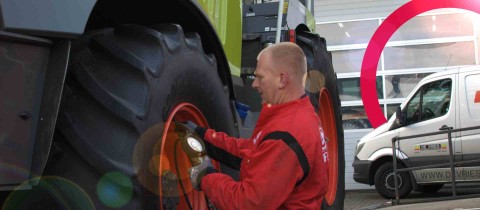The optimal tyre pressure for your agricultural tyres
Tyre pressure for agricultural vehicles
One of the major challenges in terms of tyre pressure is an attached implement. The extra weight behind the tractor's centre of gravity creates leverage in certain situations, which causes load changes.
Taking an attached plough as an example, there is a big difference when it is horizontal (working position) or raised (transport position); like when driving on the road. This also includes the difference in speed between the two positions. The changed centre of gravity makes the tractor want to tilt backwards, as the front axle is less loaded and the rear axle becomes heavier.
Regardless of the type of implement, the pressure in the tyre should always be adjusted to the highest load. In the situation mentioned, the pressure in the rear tyre should be doubled on average. However, this is far from ideal for working in the field. So every time the surface (and speed) changes, we recommend adjusting the tyre pressure. If this is too cumbersome or not possible, one option is to choose a tyre with a large air chamber and the same rolling circumference. However, this option is not always possible due to the width of the plough front.
Wheel load and speed
Decisive for tyre pressure are both the wheel load - this can be calculated on paper or found by weighing (literally) - and the operating speed. To determine the correct value, consult the usage tables of the tyre brand used. Do not use a general table or one from another brand, as there are sometimes big differences between brands for the same type of tyre. Together with the experts at Heuver, the right tyre for the right use with the right pressure can always be found.
Tyre pressure chart for agricultural tyres
A standard tyre has an ideal balance between the load per tyre in kilograms, the speed in km/h and the air pressure. This triangular relationship ensures optimum ease of use. If you adjust one of these things, for example a higher maximum speed while the load remains the same, then you should also adjust the tyre pressure. The tyre pressure table below lists possible combinations.
|
|
Load capacity (kg) at tyre pressure (bar) | ||||||
|
KM/h |
1 |
1,3 |
1,6 |
2 |
|||
|
10 |
4820 |
5680 |
6430 |
7180 |
|||
|
15 |
4500 |
5300 |
6000 |
6700 |
|||
|
20 |
4500 |
5300 |
6000 |
6700 |
|||
|
65 |
4500 |
5300 |
6000 |
6700 |
|||
|
70 |
4100 |
4820 |
5460 |
6100 |
|||
Avoid unnecessary wear on your agricultural tyres
Correct tyre pressure is important both in the field and on the road to avoid unnecessary stress and wear on tread and casing. Driving with too low a pressure and at too high a speed results in too much flexing of the tyre. As a result, the temperature in the tyre rises too high and the sidewall is overloaded. On land, the wrong pressure can mean that the agricultural tyre rotates around the rim and folds in the sidewall. The tyre wears out more quickly, preventing optimum performance.
Pressure-changing system for agricultural tyres
With a pressure-changing system, you can always get the most out of your tyres. On the road, you drive with a high pressure and in the field you release the pressure to increase the contact surface and spare the soil. This system is particularly interesting for large self-propelled harvesters, manure spreaders and heavy tractors with trailers that do a lot of combined field and transport work.
In the field, a pressure changing system saves 7% to 10% fuel (source: SVOB Foundation). On paved roads, the savings vary depending on the situation: with just a tractor, you save 5%, with an implement 12% and with a trailer as much as 17% fuel. Moreover, your tyres will wear 30% less than without a pressure-changing system. Of course, you also save time and the reduced soil compaction gives you several percent more yield.
Fitting tyres on a narrower rim
IF and VF tyres are mounted on a wider rim than standard radial tyres. Why? To increase air volume and maintain tyre stability. When a manufacturer has developed the tyres with a Narrow Rim Option (NRO), these tyres may be mounted on a narrower rim than advised. This is to ease the transition from standard tyres to IF or VF tyres and make the overall investment smaller.
Please note that NRO is not readily available with every brand or size. To ensure tyre stability, the tyres often need to be used with higher inflation pressures than is normally the case with IF and VF tyres.
Like to know more?
Do you need advice? Please contact us, our experts will be pleased to assist you. Contact our experts at +31 (0)523 - 850 850 or by e-mail to info@heuver.com. You can also read all about agriculture on the agricultural knowledge-page.

